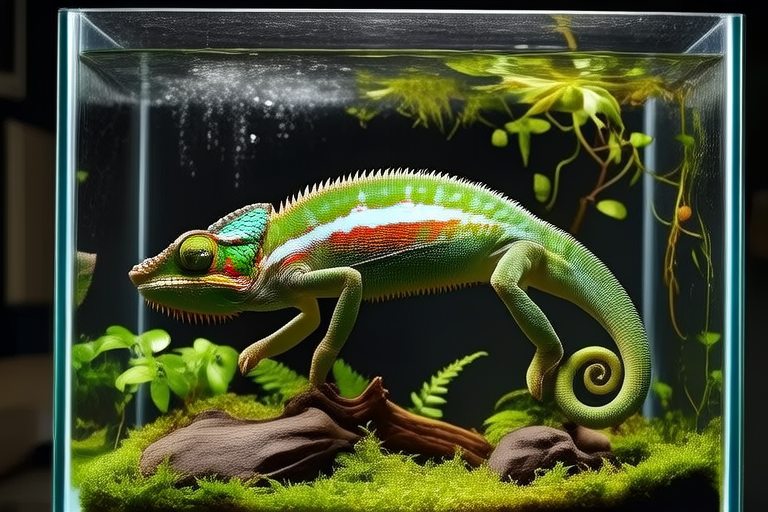From Jungle to Living Room: Transforming Your Space for a Chameleon
Welcome to the fascinating world of chameleons! These unique reptiles, known for their ability to change color, have captivated animal enthusiasts for centuries. Bringing a chameleon into your home is an exciting endeavor that requires careful planning and attention to detail. This guide will walk you through the process of transforming your living space into an ideal habitat for your scaly friend, ensuring they thrive in their new environment.
Understanding Chameleon Habitat Needs
Chameleons are arboreal creatures native to tropical regions such as Madagascar, Africa, and parts of Asia. Their natural habitats include dense forests, savannas, and rocky outcrops. To provide the best care for your pet chameleon, it’s crucial to replicate these conditions as closely as possible. A well-designed enclosure will mimic the chameleon’s natural environment, promoting physical and psychological health.
Selecting Appropriate Enclosures
The first step in creating a suitable habitat is choosing the right enclosure. Opt for a vertically oriented tank with ample height, as chameleons are climbers and need vertical space to move around comfortably. A minimum size of 24 inches by 18 inches by 36 inches (height) is recommended for juveniles, while adults require larger tanks measuring at least 48 inches by 24 inches by 72 inches. Ensure the enclosure has good ventilation and secure mesh sides to prevent escapes and allow proper air circulation.
Creating a Balanced Environment
Temperature and Humidity
Maintaining the correct temperature gradient is vital for your chameleon’s health. Install a digital thermometer and hygrometer to monitor these levels accurately. The ambient temperature should range between 75°F and 85°F (24°C to 29°C), with a basking spot reaching approximately 90°F to 95°F (32°C to 35°C). Use heat lamps or ceramic heaters to achieve this warmth. For humidity, aim for 50% to 70%, which can be maintained by misting the enclosure daily and providing a water drip system.
Lighting
Proper lighting is essential for chameleons’ overall health. Full-spectrum UVB lighting is necessary for calcium metabolism and vitamin D3 synthesis. Place the light fixture about 12 to 18 inches above the substrate, ensuring the chameleon can bask under it. Replace bulbs every six months, even if they still appear functional, as UV output diminishes over time. Supplemental heating and lighting should be controlled by timers to simulate day-night cycles.
Choosing the Right Plants and Decorations
Incorporating live plants enhances both aesthetics and functionality within the enclosure. Choose non-toxic species like pothos, schefflera, and ficus benjamina. These plants offer hiding spots, climbing opportunities, and help maintain humidity levels. Arrange branches and vines strategically to encourage exploration and movement. Avoid overcrowding the enclosure, leaving enough open space for the chameleon to bask comfortably.
Setting Up Feeding Stations
Feeding chameleons requires specific techniques to ensure they receive adequate nutrition. Offer a variety of insects, including crickets, dubia roaches, and silkworms. Dust these insects with a calcium supplement and multivitamin powder before each feeding session. Use small containers or feeding clips to present food items securely, preventing them from escaping and potentially causing harm.
Ensuring Safety from Predators and Hazards
Chameleons are vulnerable to various threats, including household pets and environmental dangers. Keep the enclosure away from areas where other animals might pose a risk. Regularly inspect the enclosure for sharp edges, loose wiring, or any potential hazards. Ensure all equipment is securely fastened and functioning correctly to prevent accidents.
Regular Maintenance Tips
To keep your chameleon’s habitat clean and healthy, perform routine maintenance tasks. Clean the enclosure weekly by removing waste and wiping down surfaces. Replace soiled substrates promptly to minimize bacterial growth. Disinfect water bowls and feeding dishes regularly using a reptile-safe cleaner. Monitor the chameleon’s behavior and appearance for signs of illness, seeking veterinary assistance if necessary.
Advice on Integrating the Chameleon into Your Living Space Harmoniously
Integrating a chameleon into your home involves more than just setting up its enclosure; it also means adapting your lifestyle to accommodate its needs. Position the enclosure in a quiet area away from direct sunlight and drafts. Establish a routine for feeding, cleaning, and handling your chameleon, ensuring consistency and predictability. Familiarize yourself with local regulations regarding exotic pets to avoid legal issues.
By following these guidelines, you’ll create a nurturing environment where your chameleon can flourish. Remember, the key to successful chameleon ownership lies in understanding and replicating their natural habitat. With patience, dedication, and proper care, your new companion will bring joy and wonder to your life.
